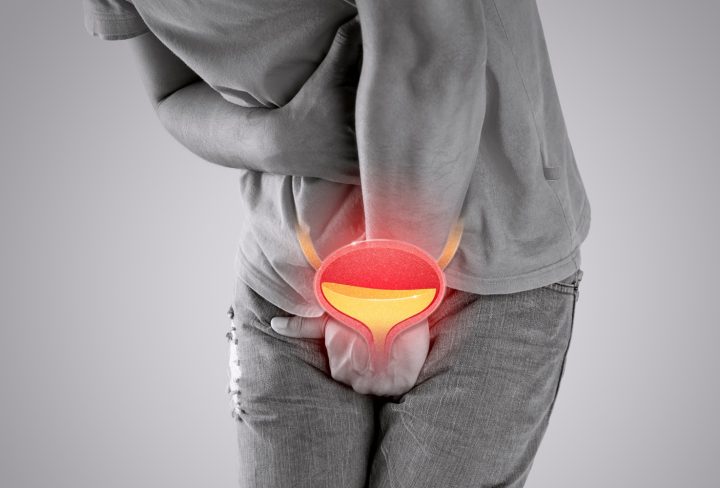The prostate gland is a tiny organ about the size of walnut below the bladder. It surrounds the top portion of the tube that drains urine from the bladder (urethra). The prostate and other sex glands produce the fluid that transports sperm during ejaculation, semen.
Prostatitis is a condition of the prostate gland associated with inflammation. Prostatitis often causes painful or difficult urination and pain in the groin and pelvic area. Bacterial infections are the common cause of prostatitis.
Prostatitis Symptoms
Some of the common symptoms of prostatitis include:
- Pain or burning sensation when urinating
- Dribbling or hesitant urination
- Frequent urination at nights
- Urgent need to urinate
- Cloudy urine or bloody urine
- Pain in the abdomen or groin
- Pain in the area between the scrotum and rectum
- Pain in the penis or testicles
- Painful ejaculation
- Flu-like symptoms (fever and chills)
Prostatitis Causes
Causes are different for different types of prostatitis:
- Acute bacterial prostatitis: Acute prostatitis is caused by common strains of bacteria. The infection is spread from other parts of the urinary or reproductive systems.
- Chronic bacterial prostatitis: Chronic prostatitis may occur when treatment for acute infection is not long enough or fails to kill all the bacteria.
- Asymptomatic inflammatory prostatitis
Risk factors of Prostatitis (Swelling of the Prostate):
- Young or middle-aged adulthood
- History of prostatitis
- Infection of the urinary system
- HIV infection
- Use of a urinary catheter (a tube inserted to drain the bladder)
- During biopsy (sampling of prostate tissue)
Complications of Prostatitis
- Sexual dysfunction
- Bacteremia (Bacterial infection of the blood)
- Epididymitis (Inflammation of the tube attached to the testicle)
- A prostatic abscess (Pus-filled cavity in the prostate)
- Infection that spreads to the pelvic bone or spine
Prostatitis Diagnosis
Your urologist will assess your symptoms and perform a physical exam. Also, they will order less invasive tests for prostatitis, which include:
- Digital rectal examination: Your doctor inserts a gloved and lubricated finger into the rectum to check the prostate gland. This exam may include a prostate massage to collect a sample of seminal fluid.
- Urinalysis: To check for bacteria and UTIs
- Blood test: To measure PSA, a protein made by the prostate gland. Elevated levels may indicate prostatitis, BPH, or prostate cancer
More invasive tests for prostatitis are ordered if the above tests did not help in confirming the diagnosis. The tests include:
- Cystoscopy: To look for other urinary tract problems; however, it does not diagnose prostatitis. Your provider uses a cystoscope (camera) to view the bladder and urethra.
- Transrectal ultrasound: If antibiotics do not improve your condition, you must undergo this test. An ultrasound probe inserted into the rectum uses sound waves to produce images of the prostate gland. This helps show prostate gland abnormalities, abscesses, or stones.
Prostatitis Treatment
Prostatitis medications for infection
Your doctor will prescribe the best antibiotics for acute or chronic prostatitis. Acute disease may require intravenous (IV) antibiotics, and there might be a need to stay in the hospital for a short period.
The entire course of antibiotic treatment is 4 to 6 weeks or maybe longer in some cases. Taking all the prescribed medication is essential for infection relapse and reducing the risk of chronic bacterial prostatitis.
When treating urinary symptoms, alpha-blockers help relax the bladder, neck, and muscle fibers. This treatment would ease urinary symptoms, such as painful or difficult urination. In contrast, this is commonly prescribed for men with chronic prostatitis/pelvic pain syndrome.
Treating pain
Your doctor may prescribe pain medication or non-prescription drugs like acetaminophen or ibuprofen.
Managing psychological symptoms
A mental health care professional recommends psychotherapy to help you manage stress, depression or anxiety associated with chronic pain.
Prevention of Prostatitis
Prompt treatment for UTIs may keep the infection from spreading to the prostate. When sitting, consult your doctor if you have pain in your perineum (area between the anus and scrotum). You can take medical guidance to address this problem before it leads to chronic pelvic pain syndrome.
Conclusion
Prostatitis is a common condition that affects many men at some point in their lives. While it can be uncomfortable and painful, proper diagnosis and treatment can alleviate symptoms and improve quality of life. Men need to pay attention to any changes or discomfort in the genital or urinary area and seek medical attention if necessary. With prompt treatment and care, prostatitis can be effectively managed.

